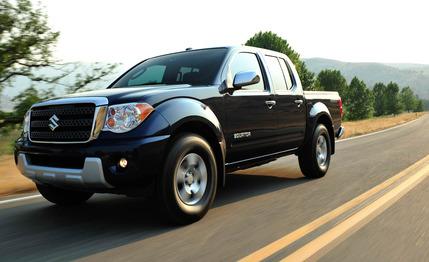 First Drive Review
First Drive Review
The first question we asked was, Why?
Why did Suzuki and Nissan apparently agree that a regrilled Frontier belongs in Suzuki showrooms? The answer, of course, is that Suzuki doesn’t sell a pickup in the U.S. (never has, actually), and Nissan evidently needs some A-segment cars in other countries.
But doesn’t Suzuki build trucks for other markets it could bring here? “Nothing in the displacement category that Americans demand,” according to a Suzuki spokesman. Cribbing the Tennessee-built Nissan is also a handy way to avoid the decades-old “chicken tax” that levies a huge tariff on trucks built outside the good ol’ U.S. of A.
Who’s going to buy it from Suzuki when Nissan has better dealership coverage, more practiced mechanics, and a wider array of model offerings? Well, Suzuki hopes that some 10 percent of Suzuki’s 200,000 or so annual ATV and motorcycle customers will be loyal or gullible enough to want to stay with the brand when time comes to buy something to haul those toys. Fair enough—it’s sort of like buying your TV and DVD player from the same company in hopes that you only need one remote to work them.
We presume, however, that most such active-lifestyle types will be able to pick out the Nissan within, even if the Toyota Tacoma–esque headlights throw them off for a minute, so it really comes down to a matter of saving the customer a trip to the Nissan store. The Equator also has a standard seven-year/100,000-mile powertrain warranty—two years and 40,000 miles more than the Nissan is willing to offer on its own version. That’s the most compelling reason we’ve heard so far to choose the Suzuki.
A Frontier by Any Other Name, Evidently, Is an Equator
We sampled an Equator to see just how different it might be from the Frontier, which we’ve enjoyed in various forms since its 2005 growth spurt brought it into the livable mid-size category, even designating it one of the Top 10 Hooligan Cars for 2008 in its now discontinued two-wheel-drive NISMO guise.
What we found was that aside from the big grille and reshaped headlamps, it isn’t any different at all. Like the Nissan, the Equator is available in two cab lengths—extended and crew—with a choice of a 2.5-liter four-cylinder that produces 152 hp and 171 lb-ft of torque or a 4.0-liter V-6 that pumps out a healthy 261 hp and 281 lb-ft. The latter engine comes paired only with a five-speed automatic and is the only mill available with the crew-cab body style. Our two-wheel-drive, short-box crew-cab V-6 example came in mid-grade Sport array, and as with the Frontier, the engine is willing, albeit as loud and grumbly as you’d expect given its displacement. The fully boxed frame indeed exhibits plenty of stiffness, but predictably, handling is as trucky as trucks get these days—bumpy and bouncy with little steering feel. The silky Tacoma V-6 is miles more refined by comparison.
The same applies inside, where the Frontier’s hard plastic parts and Nissan-orange dashboard lighting are no more attractive in Suzuki guise. Still, the interior is well laid out, with a double-decker glove box and a reasonably long list of features available to dress up the space convincingly, although forget about leather—Nissan has kept that for itself. One happy carry-over from the Frontier is the optional Rockford Fosgate sound system that comes with a Sport package available for the 4WD-only RMZ trim. Also convenient for Suzuki buyers is the availability of a long list of custom accessories right at launch, thanks in no small part to existing aftermarket items for the Frontier.
A New Frontier
Prices for the Equator line begin at just under $18,000 for the extended-cab model, and the top-of-the-line RMZ-4 Sport is $31,375, plus options. Those prices essentially bookend the wider array of Frontier models, which begin at $18,240 and rise to $30,520. The Equator we drove in Los Angeles came in at $25,269, having been optioned with $119 floor mats but nothing else. This seems like a good enough deal for a competent, mid-size truck wearing rugged—if rather indistinct—attire. Going crazy at the accessories store with a higher trim would yield a more exciting proposition, to be sure. If off-the-rack “customization” is your thing, though, the Frontier offers more trim levels and options.
Will throngs of people flock to Suzuki for a pickup in a market where nothing is selling? We doubt it. Then again, Suzuki says it would consider 20,000 sales per year successful, and especially with its standout warranty, we think that modest total could be possible if the economy shapes up even slightly.
If nothing else, it’s nice to have a choice of Frontiers in which to explore.